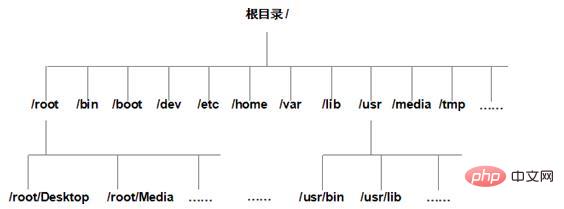What does path mean in linux
The path in Linux refers to the entire file name and the location of the file. This positioning is called a path; there are two ways to specify the location where a file is stored, namely using absolute paths and relative paths; absolute The path is relative to the root path. As long as the file does not move, its absolute path is constant; while the relative path is relative to the current directory. As the program executes, the current directory may change. , so the relative path of the file is not fixed.

#The operating environment of this tutorial: linux5.9.8 system, Dell G3 computer.
What is the path in Linux?
The location of the path
Includes the entire file name and the location of the file, like this Positioning is called a path
Path is a way to locate files



. #表示的是当前所在的目录 .. #当前目录的上一级目录 ./ #表示当前的目录 . #表示当前的目录 ../ #从当前目录的上一级目录开始 .. #上一级目录
Linux absolute path and relative path detailed explanation
Specify the location where a file is stored. There are two methods, using absolute paths and relative paths.
We know that all files (directories) in the Linux system are organized into an inverted tree structure starting from the root directory "/", as shown in Figure 1.
 Linux system file organization structure diagram
Linux system file organization structure diagram
The absolute path must start from the root directory /. For example, use an absolute path to indicate the location of the bin file. The path should be written as /usr/bin. The test code is as follows:
[root@localhost ~]# bin bash: bin: command not found <-- 没有找到 [root@localhost ~]# /usr/bin bash: /usr/bin: is a directory <-- 是一个文件
Different from absolute paths, relative paths do not start from the root directory /, but start from the current working directory. When using relative paths to indicate the storage location of a file, the two special directories mentioned earlier are often used, namely the current directory (represented by .) and the parent directory (represented by ..).
For example, when we log in to the Linux system as root, the current working directory defaults to /root. If we need to adjust the current working directory to the root subdirectory Desktop, of course we can use the absolute path. , the sample code is as follows:
[root@localhost ~]# pwd <-- 显示当前所在的工作路径 /root [root@localhost ~]# cd /root/Desktop [root@localhost Desktop]# pwd /root/Desktop
[root@localhost ~]# pwd <-- 显示当前所在的工作路径 /root [root@localhost ~]# cd ./Desktop [root@localhost Desktop]# pwd /root/Desktop
To give another example, if you log in to the Linux system as root and convert the current working directory from /root to the /usr directory, there are two ways:
#使用绝对路径 [root@localhost ~]# pwd <-- 显示当前所在的工作路径 /root [root@localhost ~]# cd /usr [root@localhost ~]# pwd /usr #使用相对路径 [root@localhost ~]# pwd <-- 显示当前所在的工作路径 /root [root@localhost ~]# cd ../usr <-- 相对 root,usr 位于其父目录 /,因此这里要用到 .. [root@localhost ~]# pwd /usr
Linux Video Tutorial"
The above is the detailed content of What does path mean in linux. For more information, please follow other related articles on the PHP Chinese website!

Hot AI Tools

Undresser.AI Undress
AI-powered app for creating realistic nude photos

AI Clothes Remover
Online AI tool for removing clothes from photos.

Undress AI Tool
Undress images for free

Clothoff.io
AI clothes remover

Video Face Swap
Swap faces in any video effortlessly with our completely free AI face swap tool!

Hot Article

Hot Tools

Notepad++7.3.1
Easy-to-use and free code editor

SublimeText3 Chinese version
Chinese version, very easy to use

Zend Studio 13.0.1
Powerful PHP integrated development environment

Dreamweaver CS6
Visual web development tools

SublimeText3 Mac version
God-level code editing software (SublimeText3)

Hot Topics
 What computer configuration is required for vscode
Apr 15, 2025 pm 09:48 PM
What computer configuration is required for vscode
Apr 15, 2025 pm 09:48 PM
VS Code system requirements: Operating system: Windows 10 and above, macOS 10.12 and above, Linux distribution processor: minimum 1.6 GHz, recommended 2.0 GHz and above memory: minimum 512 MB, recommended 4 GB and above storage space: minimum 250 MB, recommended 1 GB and above other requirements: stable network connection, Xorg/Wayland (Linux)
 How to run java code in notepad
Apr 16, 2025 pm 07:39 PM
How to run java code in notepad
Apr 16, 2025 pm 07:39 PM
Although Notepad cannot run Java code directly, it can be achieved by using other tools: using the command line compiler (javac) to generate a bytecode file (filename.class). Use the Java interpreter (java) to interpret bytecode, execute the code, and output the result.
 Linux Architecture: Unveiling the 5 Basic Components
Apr 20, 2025 am 12:04 AM
Linux Architecture: Unveiling the 5 Basic Components
Apr 20, 2025 am 12:04 AM
The five basic components of the Linux system are: 1. Kernel, 2. System library, 3. System utilities, 4. Graphical user interface, 5. Applications. The kernel manages hardware resources, the system library provides precompiled functions, system utilities are used for system management, the GUI provides visual interaction, and applications use these components to implement functions.
 vscode cannot install extension
Apr 15, 2025 pm 07:18 PM
vscode cannot install extension
Apr 15, 2025 pm 07:18 PM
The reasons for the installation of VS Code extensions may be: network instability, insufficient permissions, system compatibility issues, VS Code version is too old, antivirus software or firewall interference. By checking network connections, permissions, log files, updating VS Code, disabling security software, and restarting VS Code or computers, you can gradually troubleshoot and resolve issues.
 Can vscode be used for mac
Apr 15, 2025 pm 07:36 PM
Can vscode be used for mac
Apr 15, 2025 pm 07:36 PM
VS Code is available on Mac. It has powerful extensions, Git integration, terminal and debugger, and also offers a wealth of setup options. However, for particularly large projects or highly professional development, VS Code may have performance or functional limitations.
 How to use VSCode
Apr 15, 2025 pm 11:21 PM
How to use VSCode
Apr 15, 2025 pm 11:21 PM
Visual Studio Code (VSCode) is a cross-platform, open source and free code editor developed by Microsoft. It is known for its lightweight, scalability and support for a wide range of programming languages. To install VSCode, please visit the official website to download and run the installer. When using VSCode, you can create new projects, edit code, debug code, navigate projects, expand VSCode, and manage settings. VSCode is available for Windows, macOS, and Linux, supports multiple programming languages and provides various extensions through Marketplace. Its advantages include lightweight, scalability, extensive language support, rich features and version
 How to check the warehouse address of git
Apr 17, 2025 pm 01:54 PM
How to check the warehouse address of git
Apr 17, 2025 pm 01:54 PM
To view the Git repository address, perform the following steps: 1. Open the command line and navigate to the repository directory; 2. Run the "git remote -v" command; 3. View the repository name in the output and its corresponding address.
 laravel installation code
Apr 18, 2025 pm 12:30 PM
laravel installation code
Apr 18, 2025 pm 12:30 PM
To install Laravel, follow these steps in sequence: Install Composer (for macOS/Linux and Windows) Install Laravel Installer Create a new project Start Service Access Application (URL: http://127.0.0.1:8000) Set up the database connection (if required)






